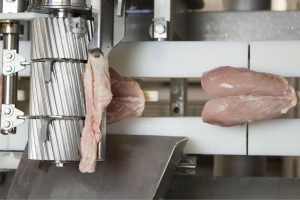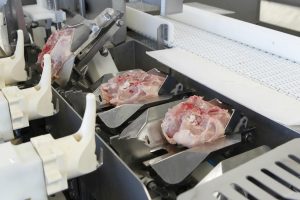Stork AMF-i Sets the World’s Benchmark – Breast Cap Filleting Meets Intelligence

Breast cap deboning is an extremely important stage in any poultry processing plant. During this process, end products with the highest value, such as breast fillets and tenderloins, should be harvested in the most accurate and consistent way with highest yield. That’s why markets around the world ask for the most efficient automated solutions to facilitate and assist in breast cap filleting. In this respect, the Stork AMF-i sets a new benchmark.
Since its origin in 1996 the Stork AMF system is the leading solution worldwide in breast cap deboning; with hundreds of systems in operation globally it is a huge success. Continuous development keeps opening up new product opportunities for this system, at the same time maximizing deboning efficiency, quality and yield. In this way the AMF solution continues to be the benchmark in breast cap deboning. The most renowned firms in every part of the world prove that the AMF system is performing excellently under all circumstances, for all capacities.
Fully Automated
The newest AMF-i generation not only produces a wide range of breast fillet products for the retail industry but also harvests valuable by-products, such as skin, breast tendon meat and breast cartilage. Almost all filleting operations can be done automatically, thus saving manual labor. A full-scale AMF-i deboning system would comprise modules carrying out the following tasks: breast cap loading, deskinning, breast blister removal, wishbone removal, fillet halving, fillet separation, tendon trimming, tenderloin separation, keel ribbon harvesting and cartilage harvesting.
 Influence of Fluctuations Eliminated
Influence of Fluctuations Eliminated
Poultry processors typically handle a substantial flock weight variance, causing significant differences in breast cap size and weight. For optimum yield and top product quality it is essential that modules are set correctly for the size of breast cap being processed. Thanks to AMF-i’s newly added intelligence, processors don’t need to calibrate their input anymore, nor have to select product size related recipes for module settings. The measurement unit determines the dimensions of every single incoming product. Based on this measured data, the downstream AMF-i modules automatically adjust their settings accordingly. In this way, the influence of incoming breast cap fluctuations are eliminated, ensuring the most optimal yield per individual breast cap.
Modular Set-up
Breast caps are automatically conveyed through the modules. Turning stations position the holder correctly for each processing operation. Each module is responsible to handle one specific process step and modules can be switched on or off to create different end products. Every individual poultry processor can choose their own preferred line-up of modules, whichever suits them best. The system can debone a wide range of breast cap weights into a wide range of skin-on or skinless breast fillet products, varying from whole butterflies with tenderloins attached to half fillets with tenderloins harvested separately.
Just one example of a measurement-guided module is the Wishbone Remover-i. Instead of using an average setting for this module, the cam-controlled knife can be set to cut in two different ways. Depending on the product’s size, the right settings are automatically regulated by PLC control. This highly reliable way of cutting out the wishbone results in considerably increased fillet yield.
Changing Orders
Thanks to the measurement unit, consistent adaptive filleting can be done without human intervention needed. Top yield and quality are therefore guaranteed across the whole range of breast cap weights and on all breast fillet products. The AMF-i intelligence gives processors optimum flexibility to react swiftly and adequately to fast changing order requirements from their customers.
For more about AMF-i visit www.marel.com/amf-i.


































